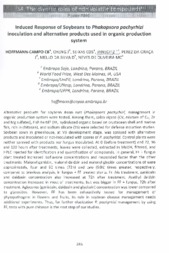Induced response of soybeans to phakopsora pachyrhizi inoculation and alternativa products used in organic production system.
Induced response of soybeans to phakopsora pachyrhizi inoculation and alternativa products used in organic production system.
Author(s): HOFFMANN-CAMPO, C. B.; CHENG, J.; SEIXAS, C. D. S.; JANEGITZ, T.; GRAÇA, J. P. da; SILVA, D. M. da; OLIVEIRA, M. C. N. de
Summary: Alternative products for soybean Asian rust (Phakopsora pachyrhizi) management in organic production system were tested. Among them, calda viçosa (CV, mixture of Cu, Zn and Mg sulfates), Fish Fertil" (FF, hydrolyzed organic based on crustacean shell and marine fish, rich in chitosan), and sodium silicate (55) were selected for defense induction studies. Sovbean sown in greenhouse, at V3 development stage, was sprayed with alternative products and inoculated or not-inoculated with spores of P. pachyrhizi. Control plants were neither sprayed with products nor fungus inoculated. At O (before treatment) and 72, 96 and 120 hours after treatments, leaves were collected, extracted in MeOH, filtered, and HPLC injected for identification and quantification of compounds. In general, FF + fungus plant treated increased isoflavone concentrations and responded faster than the other treatments. Malonyl genistin, malonyl daidzin and malonyl glycitin concentrations of were approximately, four and 90 times (72h) and two (96h) times greater, respectively, compared to previous analysis, in fungus + FF treated plants. In this treatment, genistein and daidzein concentration also increased at 72h after treatment. Acethyl daidzin concentration increased in most of treatments, but was bigger in FF + fungus, 72h after treatment. Aglycones (genistein, daidzein and glycitein) concentration was lower compared to glycosides. However, FF has been exhaustively tested for management of phytopathogens in flowers and fruits, its role in soybean disease management needs additional experiments. Thus, for further elucidation P. pachyrhizi management by using FF,tests with pure chitosan is the next step of our studies.
Publication year: 2010
Types of publication: Abstract in annals or event proceedings
Unit: Embrapa Soybean
Keywords: Non volatile compounds
Observation
Some of Embrapa's publications are published as ePub files. To read them, use or download one of the following free software options to your computer or mobile device. Android: Google Play Books; IOS: iBooks; Windows and Linux: Calibre.
Access other publications
Access the Agricultural Research Database (BDPA) to consult Embrapa's full library collection and records.
Visit Embrapa Bookstore to purchase books and other publications sold by Embrapa.

